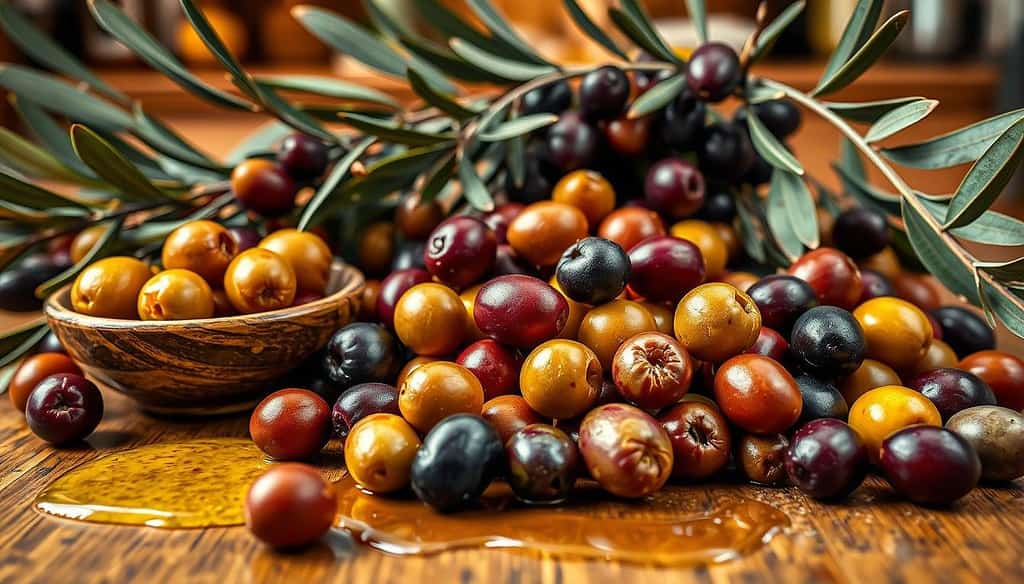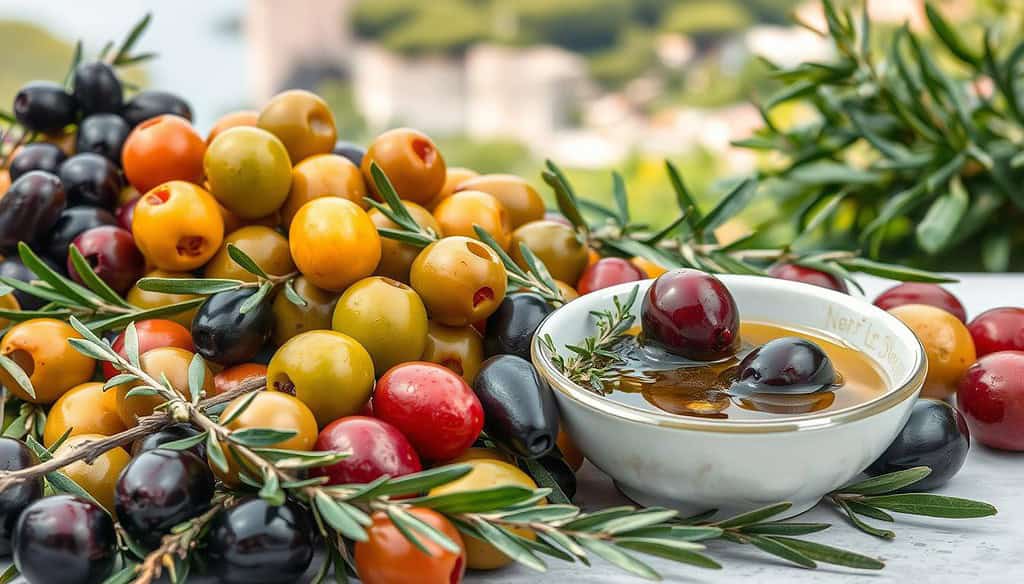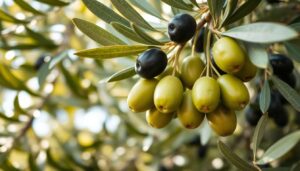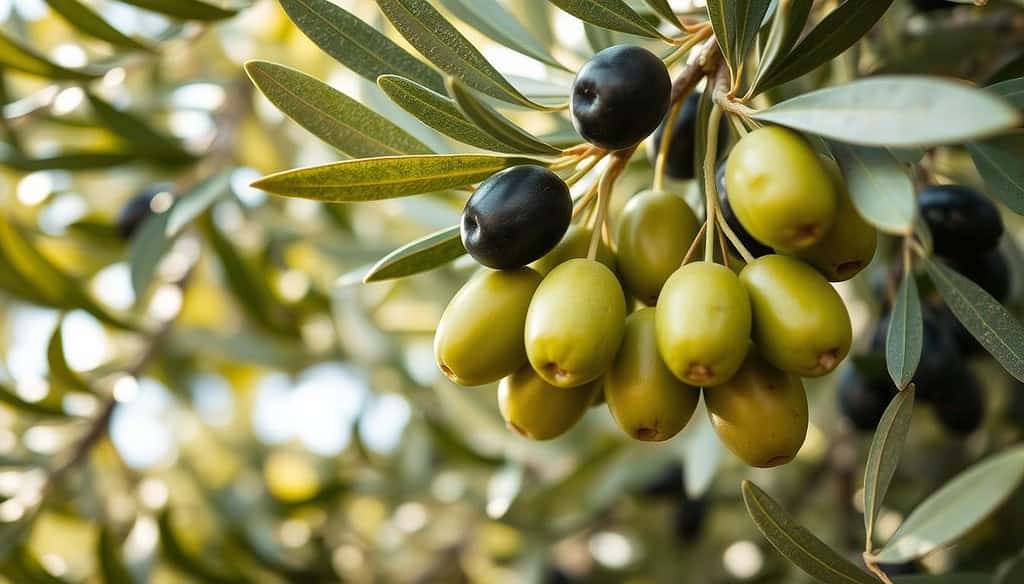Olives fascinate me as a gardener. These small, oval-shaped morsels have been a global culinary staple for millennia. But are they truly a fruit?
Surprisingly, olives are classified as fruits. They grow on olive trees and develop from the plant’s ovary. As they ripen, olives change color from green to purple, brown, and black.
Olives differ from typical fruits in flavor. Instead of sweetness, they offer a savory, sometimes briny taste. This unique flavor comes from their high content of healthy fats, vitamins, and minerals.
Olives belong to a special fruit category called drupes. This family includes peaches and cherries. There are over a thousand olive types, each with its own flavor.
Interestingly, raw olives are incredibly bitter. They become edible through careful curing processes. These involve brine, dry salt, water, or lye treatments.
Curing is an art form. It varies in duration and results in different flavor intensities. This process transforms olives into the delectable treats we enjoy.
Key Takeaways
- Olives are classified as fruits, specifically drupes
- They change color as they ripen, from green to black
- Olives are rich in healthy fats, vitamins, and minerals
- Raw olives are bitter and require curing to be edible
- There are over 1,000 varieties of olives worldwide
- Olive cultivation is widespread, especially in Mediterranean regions
- Curing methods greatly influence the final flavor of olives
The Botanical Classification of Olives
Olives are a fascinating fruit from the Mediterranean. They’re part of a unique botanical family. Let’s explore what makes these tasty drupes special.
Understanding Drupes: The Olive’s Fruit Family
Olives are drupes, fruits with a fleshy exterior and hard pit inside. They’re related to peaches, plums, and cherries. Olives have three main parts: the skin, flesh, and pit.
Olive Tree Characteristics: Olea europaea
Olive trees, or Olea europaea, belong to the Oleaceae family. This family has 600 species in 24 genera worldwide. Some olive trees are over 2,000 years old.
These hardy trees can grow between 3 to 12 meters tall. Some can even reach heights of over 40 feet.
From Green to Black: The Ripening Process
Olives change from green to purple to black as they ripen. This affects their flavor and texture. Green olives are firmer and bitter.
Black olives are sweeter and softer. Ripening also increases the fruit’s oil content. It can reach about 20-30% of fresh weight.
| Olive Stage | Color | Texture | Flavor |
|---|---|---|---|
| Unripe | Green | Firm | Bitter |
| Semi-ripe | Purple | Softer | Less bitter |
| Fully ripe | Black | Soft | Complex, sweet |
Most harvested olives (80%) are used for olive oil production. Only 20% become table olives. People have grown olives for about 7,000 years in Mediterranean regions.
Are Olives a Fruit?
Olives are indeed a fruit, classified as drupes. Their savory taste might make you think they’re vegetables. But their botanical structure tells a different story. Olives have a fleshy exterior and a central stone containing the seed.
This structure resembles other drupes like peaches, cherries, and plums. Botanically, olives are fruits. Yet, their culinary use often blurs the line between fruit and vegetable.

You’ll find olives in savory dishes more than sweet ones. This unique feature makes them versatile in many cuisines. Olives come in various types, including green, black, pitted, unpitted, and stuffed varieties.
The color of olives changes as they ripen. They start green and progress to purple and black. Fresh olives from the tree are incredibly bitter and inedible. They need curing to become palatable.
Here’s a quick comparison of olives and typical fruits:
| Characteristic | Olives | Typical Fruits |
|---|---|---|
| Taste | Savory | Sweet |
| Culinary Use | Mainly in savory dishes | Desserts and snacks |
| Edibility when fresh | Bitter, needs processing | Usually edible when ripe |
| Nutritional Profile | High in healthy fats | Often high in natural sugars |
Olives are undeniably fruits from a botanical standpoint. Their structure and development process firmly place them in the fruit category. Next time you enjoy olives, remember you’re savoring a unique fruit. They bridge the gap between sweet and savory in the culinary world.
The Journey from Tree to Table
Olives have been vital to Mediterranean life for thousands of years. Their history dates back to around 4000 BC. These fruits serve many purposes, from cooking to healing.
Raw olives are inedible due to oleuropein, a bitter compound. Curing is necessary to make them palatable. This process transforms olives into tasty treats we enjoy.
Why Raw Olives Are Inedible
Oleuropein makes raw olives too bitter to eat. You can’t pick an olive from a tree and eat it right away. Curing is essential to make olives enjoyable.
The Ancient Art of Curing Olives
Curing olives is an ancient practice. Early methods involved soaking olives in water for months. Romans found that adding lye could shorten the process to hours.
“Quality olive oil contains vitamins, amino acids, and polyphenols. Freshness is crucial, urging olives to be taken to the oil factory within hours of harvesting.”
Modern Olive Processing Techniques
Today, olive producers use various techniques to create edible olives. These include:
- Brining: Soaking olives in saltwater solution
- Dry-curing: Packing olives in salt
- Lye-curing: Using an alkaline solution to speed up the process
These methods make olives edible and give them unique flavors. California grows olives on about 15,000 acres. This accounts for 95% of U.S. olive production.
| Curing Method | Duration | Flavor Profile |
|---|---|---|
| Brining | 1-6 months | Salty, tangy |
| Dry-curing | 4-6 weeks | Intense, slightly bitter |
| Lye-curing | 1-7 days | Mild, less bitter |
Cured olives are a healthy snack. They’re low in carbs and rich in good fats. These fats and vitamin E benefit heart health.
Many olive species exist, each with unique traits. In İzmir, Turkey, Erkence, Ayvalık, and Gemlik varieties are common.
Want to learn more about cooking? Check out these expert tips on choosing the best charcoal.
Nutritional Profile and Health Benefits of Olives
Olives are nutrient-rich fruits with impressive health perks. These tiny powerhouses can give your wellbeing a significant boost. Let’s dive into their amazing benefits.
The Good Fats: Monounsaturated and Polyunsaturated
Olives are a goldmine of healthy fats. They contain 11-15% fat, with 74% being oleic acid, a heart-friendly monounsaturated fat. A cup of black olives offers 11 grams of unsaturated fat, potentially improving blood sugar levels.
Consuming more olive oil daily can reduce heart disease risk. People who eat half a tablespoon or more daily have a 19% lower risk of cardiovascular death.
Antioxidants and Vitamins in Olives
Olives are loaded with antioxidants. They’re rich in compounds like oleuropein, hydroxytyrosol, tyrosol, oleanolic acid, and quercetin. These antioxidants help combat inflammation in your body.
Olives also provide vital nutrients like vitamin E, iron, copper, and calcium. Oleocanthal in olives may help destroy cancer cells and lower breast cancer risk. It’s also linked to reduced Alzheimer’s risk.

Olives in the Mediterranean Diet
Olives are crucial to the Mediterranean diet, known for its health benefits. In the Mediterranean, 90% of olives become olive oil, a dietary staple.
Enjoy olives in various dishes. Add them to salads, pizzas, or pasta. Or make a tapenade spread for sandwiches. Just watch your salt intake with canned olives.
| Nutrient | Amount per 3.5 oz (100g) |
|---|---|
| Calories | 116 |
| Protein | 0.8g |
| Carbs | 6g |
| Fiber | 1.6g |
| Total Fat | 10.9g |
| Monounsaturated Fat | 7.7g |
Conclusion
Olives are remarkable fruits with a rich history and global impact. Over 800 million olive trees yield tasty table olives and prized extra virgin olive oil. The Mediterranean region leads, producing 93% of the world’s olives in countries like Spain, Italy, and Greece.
Olive cultivation has created an amazing variety of fruits. Over 200 olive types offer unique flavors and textures for cooking. Olives add a special touch to many dishes, from pizzas to salads.
They’re also the star of Mediterranean favorites like tapenade. Olives are packed with antioxidants that may help protect against heart disease and certain cancers.
Olive oil, especially extra virgin, is rich in heart-healthy monounsaturated fats. Studies show replacing other fats with olive oil could greatly reduce death rates from various diseases.
Each olive carries centuries of tradition. Some olive trees can live up to 1,500 years, witnessing history while providing nourishment. Enjoying olives or cooking with olive oil connects you to a timeless culinary legacy. Olives are technically a fruit, not a vegetable. They’re classified as drupes, like peaches and cherries. Despite their savory taste, olives have a fleshy exterior and a central stone containing the seed. A drupe is a fruit with a fleshy outer part and a hard seed inside. Olives belong to this family. Other drupes include peaches, plums, cherries, and mangoes. Raw olives contain oleuropein, a bitter compound that makes them unpalatable. Curing removes this bitterness, making olives enjoyable to eat. Ancient methods involved soaking olives in water for months or even years. Modern curing uses brining, dry-curing, and lye-curing. These processes make olives edible and give them unique flavors and textures. Olives contain healthy fats that can lower heart disease risk and reduce inflammation. They’re rich in antioxidants, including vitamin E, and provide iron. The Mediterranean diet, featuring olives, is linked to many health benefits. Olives change from green to purple to black as they ripen. This process affects their flavor and texture. Green olives are firmer and more bitter. Black olives are sweeter and softer with a complex flavor. FAQ
Are olives a fruit or a vegetable?
What is a drupe?
Why are raw olives inedible?
How are olives cured?
What are the health benefits of olives?
Why do olives change color as they ripen?










19 Comments
Oh I love how olives go from gross bitter balls to yummy snacks after curing! Its like magic really!!! Nature sure is wild sometimes 🍈🪄
@FruitBat24 lol yeah its like witchcraft but with salt!
‘Monounsaturated fats’ ‘polyphenols’ — these words give me life 😍 Honestly tho, more people should appreciate how good olives are for your health!
‘greek salad life’ 🙌🙌 #HeartHealthy
‘olives and oil = heart goals’ 🌿❤️
Wow, olives are fruits? Next you’ll tell me tomatoes are fruits too! Oh wait… You just did. Who knew my salad was actually a fruit salad?? 😂
@SmartAlec99 tomato? Salad? Nope thats just vegetable soup haha!!
This article had some decent info overall but come on, theres so much more about olive’s cultivation that was skipped here! Like the harvesting techniques or diseases that affect the olive trees – where’s that information???
@FactsOnlyPlz bruh it’s not a textbook chill
‘Tasty treat’? Raw olives taste like sadness until u dunk them in salt brine for a month – pls don’t try raw one unless ur into bitter flavor experiments 😂😂.
‘flavor experimnt’ sounds like my worst nightmare.
‘Raw olives challenge!’ coming soon on youtube.. not!
*Actually*, the classification of olives is quite well-known to anyone who has studied botany at even an introductory level. I’m surprised this information needed to be explained at all.
@OliviaLover Guess some of us missed that thrilling lecture about olive pits.
@OliviaLover Not everyone reads botany textbooks for fun, you know… Some ppl just wanna eat their pizza in peace!
Wait so why raw olivs taste like biting into soap?! thought I was going crazy when I tried one right off tree 💀💀 nobody told me it need ‘curing’ first.
Same here!! Thought Id been pranked when I tasted one stright from tree lmao.
@PeachyGleam Haha yeup, biting raw oliv is rookie mistake😆
I love olives but i didnt know they were FRUIT???? Thats bananas lol. Its nice to see them in same fam as cherries n peaches too. This artcle got me craving a big bowl of em now.